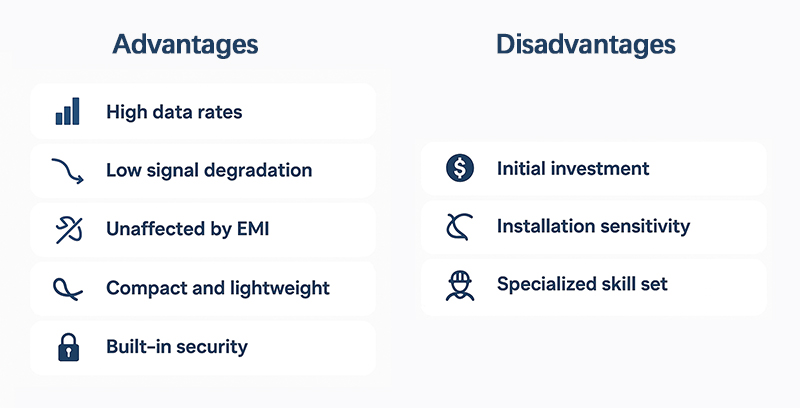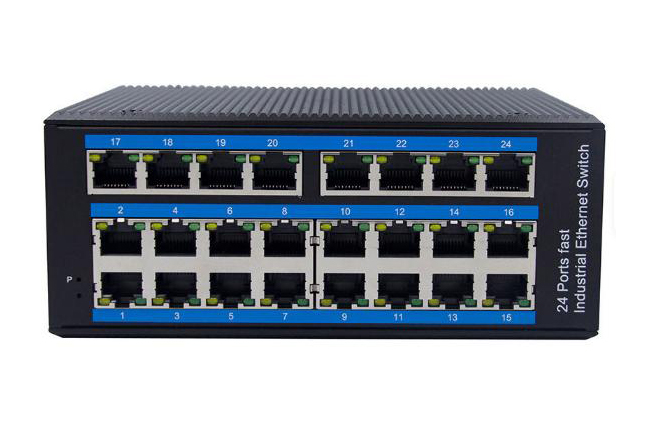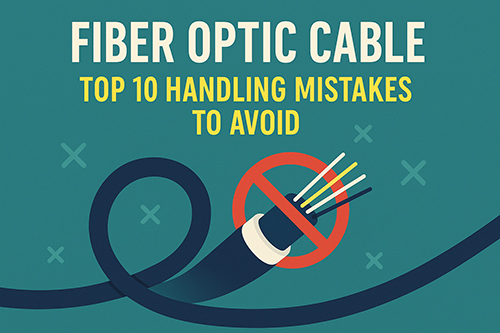.jpg)
What Are the Advantages and Disadvantages of Fiber Optic Cables
Fiber optics has increasingly taken over from copper in many high-performance communications networks. From high-capacity networks to precision sensing devices, these cables offer better data-carrying capacity and minimal signal loss. As with any material choice, though, fiber has strengths and weaknesses.

What Fiber Optics Do Well
1. Support for High Data Rates
Fiber optic cables are capable of carrying vast quantities of data at speeds over long distances without any loss. Hence, they are especially valuable for cloud-based environments, video communication, and backbone internet architecture. Single-mode fibers, in particular, bring unbelievable capacity with minimal signal loss.
2. Low Signal Degradation
Fiber performs considerably better than copper over long cable lengths. Because it transmits light instead of electricity, it avoids resistive loss that limits metal-based conductors. In most systems, that implies fewer repeaters and signal-boosting needs.
3. Unaffected by EMI
Electromagnetic interference (EMI) isn’t a problem for optical fibers, since they don’t carry electrical signals; nearby motors, transformers, or radio frequencies won’t interfere with data flow. This stability is a key reason fiber is chosen for industrial or densely packed environments.
4. Compact and Lightweight
Fiber cables are thinner and weigh less than their copper counterparts. This simplifies routing through conduit, wall panels, and server racks. When building large networks, this size advantage adds up—especially in overhead cabling or space-limited installations.
5. Built-In Security Advantages
Tapping a fiber cable is more difficult than accessing a copper line. In most cases, it’s easy to detect any physical breach or disturbance. For secure environments—finance, defense, medical—this added layer of protection is a strong selling point.
6. Durability Over Time
7. Ready for Expansion
Upgrading a fiber network doesn’t usually mean replacing all your cables. The infrastructure is designed to scale with newer transmission equipment, making it a solid choice for growing systems with increasing data needs.
Limitations to Keep in Mind
1. Initial Investment
Fiber systems cost more upfront—both in terms of materials and tools. Installing, testing, and maintaining fiber requires some specialized gear, which may be a hurdle for smaller operations.
2. Installation Sensitivity
Glass cores inside fiber strands are more delicate than copper wire. Excessive bending or pressure during installation can produce microfractures, which reduce performance or cause failure. Delicate handling is critical.
3. Specialized Skill Set
Specialized cable cutting and testing is labor-intensive. Fusion splicing, for example, is not a task most master electricians can do without special equipment and training. This restricts the number of workers and can affect project schedules.
4. Labor Costs and Availability
As the skill base is more specialist, experienced fiber installers will be harder to find—and more expensive—than for copper or coaxial installation. This is especially true in rural or developmental regions.
5. Repeaters Still Needed Over Very Long Distances
While fiber is great at maintaining signal quality, there’s still a physical limit. Undersea links or cross-continental routes often require optical amplifiers. These add cost and complexity to ultra-long-haul designs.
6. Compatibility with Legacy Systems
Fiber introduced into a copper-dominant network isn't always straightforward. You may need to employ converters, hybrid switches, or new hardware to integrate both systems. These integration processes are not only costly, but they also require time.
7. Installation Environment Matters
Before fiber is protected inside a conduit, it’s exposed during pulling and routing. Dust, water, or temperature extremes can impact how well the cable performs later. Planning around site conditions matters more than with traditional cabling.
Final Thought
Fiber optics offers a robust blend of bandwidth, reliability, and long-term dependability. For all but the simplest networks—especially those that require speed, security, and scalability—they're the medium of choice. But deployment success depends on thorough planning and the right team.
Our team at Stanford Optics collaborates with engineers, integrators, and system planners to design fiber-based solutions specific to each application's demands. Whether you're building a new network or upgrading an existing one, we can help you balance the trade-offs and optimize the value of fiber technology.
Want a deeper comparison?
Read: Fiber Optic vs. Copper Cables




